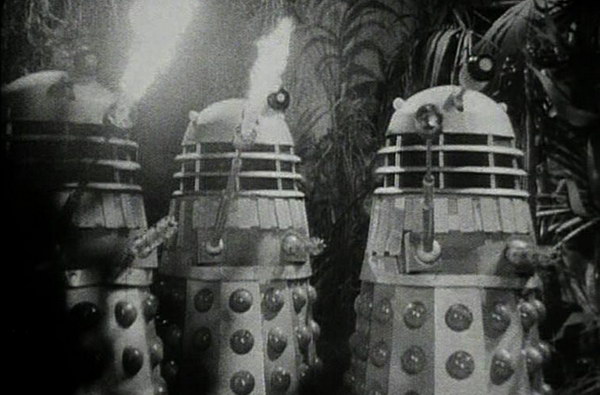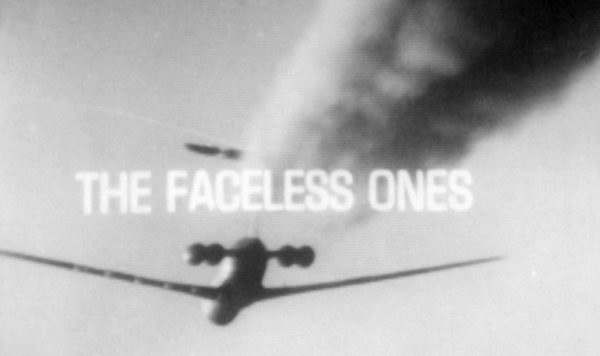|
| |
|
RECOMMENDED PURCHASE 'LOST IN TIME' DVD BOX SET (BBCDVD1353) RELEASED IN NOVEMBER 2004
BLURB A DIGITALLY RESTORED COLLECTION OF RARE 1960S' DOCTOR WHO EPISODES FROM STORIES WHICH NO LONGER EXIST IN THEIR ENTIRETY. THEY OFFER A UNIQUE GLIMPSE AT CLASSIC ADVENTURES WHICH ARE NOW LOST IN TIME...
|
|
|
Lost In Time NOVEMBER 2004 (18 EPISODES)
Lost in Time is the perfect DVD release for November 2004. With Doctor Who on the verge of an exciting new era, it seems fitting to look back at orphaned episodes and off-air audio recordings from the series’ infancy that still, for many, encapsulate the quintessence of what Doctor Who is. As the head writer of the revived series, Russell T Davies, puts it, “How romantic is that?”
As the sticker on the DVD’s cover proudly boasts, this three-disc set contains over seven hours of rare 1960s’ episodes and footage, including the recently discovered “Day of Armageddon” from 1965. Eighteen episodes are showcased in all - six featuring William Hartnell as the Doctor, and twelve from the more heavily-hit Patrick Troughton era.
The design of the discs marks a departure from previous releases as we’re treated to a beautifully-illustrated picture disc as opposed to just black print on a silver disc. The sleeve design, however, remains happily in-synch with the style used for the complete stories released to date.
The first disc houses all of the Hartnell material. The Crusade is presented in its entirety as its surviving episodes are accompanied by off-air audio recordings of the lost “Knight of Jaffa” and “The Warlords”. They’re admittedly difficult to follow without the linking narration that I’ve become accustomed to, but if you can bear with it, it will save you the cost of the BBC Radio Collection’s CD. My main problem with David Whitaker’s historical tale is that it is little more than a series of very unfortunate events. Granted, The Crusade is a series of well-written and well-acted unfortunate events, but as is the case with many Hartnell historicals, there is nothing more to the plot than the Doctor and his companions trying to escape in one piece.
Many people will have purchased this collection on the strength of the surviving trio of episodes that form a quarter of The Daleks’ Master Plan. The serial’s second episode, "Day of Armageddon”, was only returned to the BBC archives in late 2003, and as such has never seen commercial release until now. It’s wonderful to finally be able to enjoy the magnificent visuals of this episode, which include beautiful shots of Daleks in the forest with flame-throwing gunsticks and one of the most diverse assemblies of alien beings seen in the series up until this point. "Counter Plot”, meanwhile, is one of the two episodes of this serial that were reportedly recovered from a Mormon church’s basement. It has only had limited exposure in the past, having been released commercially on The Daleks – The Early Years VHS. I’m particularly fond of this episode as it showcases Jean Marsh’s Sara Kingdom - a character with an appealingly troubled, unstable edge that a lot of the Doctor’s early companions lack. "Escape Switch”, the last of the extant episodes, is the finest of the three in my opinion. It wraps up the serial’s Meddling Monk trilogy superbly – Hartnell is at his zenith, both forceful and clever, as is Kevin Stoney’s Mavic Chen, and there are also some wonderful scenes where the native Egyptians react to the Daleks.
The latest Hartnell episode to be included is “The Final Test”, the final (and probably finest) episode of The Celestial Toymaker from 1966. Michael Gough has to be given a tremendous amount of credit for his beguiling performance as the Toymaker here - he spends half the story playing a game against a silent, disembodied hand and yet he still manages to impress. Fortunately Hartnell – who had vanished part-way through the serial’s opening instalment – returns for this episode’s showdown, which unwittingly foreshadows Rassilon’s riddle in The Five Doctors – “To win is to lose, and he who wins shall lose.”
The first Doctor’s disc also serves as a compendium of odds and ends from earlier VHS releases, including William Russell’s introduction to The Crusade; surviving clips from various episodes; and the famous colour film footage showing the making of The Smugglers on location. Whilst it’s a little disappointing not to be faced by anything new, it’s great to have this material all collected together on DVD, finally enabling me to junk a few redundant videotapes.
Above: The final disc's menu
The second disc in the collection presents the orphaned episodes from Season 4 that star Patrick Troughton as the Doctor. Ironically, the first episode on the disc is Episode 3 of The Underwater Menace – in my opinion one of Troughton’s worst. The Moonbase is a cracking serial though, and can be enjoyed in full in the same way as The Crusade without having to shell out for a separate CD. Whilst it’s hard to be completely sure when considering a partially-lost treasure, I’d be tempted to put The Moonbase up there on a pedestal besides The Tomb of the Cybermen. Fast, sophisticated and surprisingly droll, this oft-neglected four-parter should probably be considered one of the second Doctor’s finest.
The Faceless Ones is another Troughton classic, and is represented on this disc by Episodes 1 and 3. The surprisingly-sympathetic Chameleons have stolen the identities of many airport personnel, resulting in a textbook “Whom can we trust?” scenario, with the Doctor put in the now-familiar position of having to try and convince the powers that be of the existence of a veiled threat – a situation that Troughton seems to delight in portraying. The second Doctor is always good at playing the fool and lulling his enemies into a false sense of security, but at times in The Faceless Ones the innocent look on the Doctor’s face as he takes Colin Gordon’s Commandant’s sarcasm perfectly literally is downright uproarious.
The disc’s highlight though is The Evil of the Daleks’ surviving second episode, which has always eluded me until now. Of all the episodes to survive, the second may not be the finest of the seven, but it may be the one that showcases the whole serial better than any other. Before I purchased this DVD I’d never seen any footage from the serial other than that included on The Tomb of the Cybermen and The Seeds of Death DVDs which depicted the sensational “final end” of the Daleks on Skaro at the end of the final episode. The existing episode may be far less explosive, but it does at least present a good cross-section of the serial as it houses the back end of the thread set in the 1960s together with the beginnings of that taking place in Theodore Maxtible’s Victorian mansion back in 1866. If you’re minded to, you can also elect to listen to Big Finish supremo Gary Russell and series star Deborah Watling sharing their thoughts on the episode.
The final DVD is just as good – if not better – than the first two as not only does it contain six seminal episodes, but also an updated version of the forty-minute Missing Years documentary presented by Frazer Hines and Deborah Watling. This programme looks at the process of junking that robbed us of over a hundred episodes of Doctor Who, incorporating some lengthy clips from episodes that are still missing. This third disc also boasts colour film footage showing the making of The Abominable Snowmen on location and Fury from the Deep in the studio, as well as surviving clips from the Australian Censor’s office from various Season 5 and 6 serials.
Above: Frazer Hines and Deborah Watling in The Missing Years documentary
With the option of another commentary from Watling and Russell, the third disc begins with Episode 2 of The Abominable Snowmen. Whilst many don’t put this first Yeti story on the lofty pedestal that they do its moody sequel, and its surviving episode shows off little of its inspiring cinematography, it is still generally considered to be one of Troughton’s finest adventures and serves as an extraordinary introduction to the Great Intelligence and their monstrous robotic servants. This is followed by the existing third episode of The Enemy of the World - an unusual adventure that takes the key tenets of the ‘historical’ format and shifts them into a near future that’s overcast by the dictatorial shadow of Salamander, the second Doctor’s unlikely doppelganger and quintessential Bond villain. As with The Abominable Snowmen though, its surviving episode is probably its weakest. Slow and studio-bound, Episode 3 lacks the action and scale of the first two, choosing instead to revel in the mundane misadventures of Watling’s Victoria.
Above: The special features on offer on the third disc
The highlight of the disc is the opening episode of The Web of Fear – without a doubt the finest story of Who’s fifth season; perhaps even of its monochrome era. In a marked contrast to the brace of adventures discussed above, we are fortunate in that Web’s surviving episode showcases so much of the serial. We can enjoy the breathtaking London Underground sets, for one thing. I’m sure that everyone will have heard the anecdote about how the London Underground refused the BBC permission to film there and so the BBC had to build their own sets, which looked so realistic that the London Underground accused them of filming there without permission, but I think it warrants repetition as it ably shows just how realistic the sets looked. Similarly, the episode offers fleeting glimpses of the redesigned Yeti, which are now sleeker and boast ferocious, glowing eyes, and a reverse-toilet flush roar. We even get to see Jack Watling reprise his role as Travers from The Abominable Snowmen, and appreciate the stalwart job that make-up artist Sylvia James did in making the character appear plausibly forty years older than he had done just a few months prior (not to mention the stalwart job that Watling did in making him older, wiser and slightly madder).
Finally, Episode 2 of Robert Holmes’ underrated sophomore effort, The Space Pirates, is presented as the final ‘orphaned’ episode in the collection. It’s ironic really that this story is so unpopular for the very reasons that Holmes’ work is generally so revered – brilliant and realistic characters, excellently written. Unfortunately most can’t forgive its dearth of monsters.
Lost in Time
is thus something of a dream come true for a Doctor Who enthusiast.
Somehow it feels like you’re getting far more for your money than you
actually are – there are just so many great stories in here, however
little of them may be left.
|
|
|
Copyright © E.G. Wolverson 2006
E.G. Wolverson has asserted his right under the Copyright, Design and Patents Act 1988, to be identified as the author of this work. |
|
|
Unless otherwise stated, all images on this site are copyrighted to the BBC and are used solely for promotional purposes. ‘Doctor Who’ is copyright © by the BBC. No copyright infringement is intended. |
|

.jpg)
.jpg)







.jpg)


 The disc then moves onto the extant
episodes of The Wheel in Space; a serial too similar to The
Moonbase to be compelling, even when commented on by then-script
editor Derrick Sherwin and the serial’s director, Tristan de Vere Cole.
Fortunately the serial’s final episode does at least show off
The disc then moves onto the extant
episodes of The Wheel in Space; a serial too similar to The
Moonbase to be compelling, even when commented on by then-script
editor Derrick Sherwin and the serial’s director, Tristan de Vere Cole.
Fortunately the serial’s final episode does at least show off 